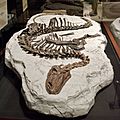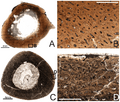Tenontosaurus facts for kids
Quick facts for kids TenontosaurusTemporal range: Lower Cretaceous
|
|
|---|---|
 |
|
| Mounted skeleton, North Carolina Museum of Natural Sciences | |
| Scientific classification | |
| Kingdom: | |
| Phylum: | |
| Class: | |
| Superorder: | |
| Order: | |
| Suborder: | |
| Infraorder: | |
| Genus: |
Tenontosaurus
Ostrom, 1970
|
| Species | |
|
|
Tenontosaurus is a type of dinosaur that lived a long time ago. Its name means "sinew lizard," which refers to the strong tendons it had along its back. This dinosaur was a medium to large-sized ornithopod, which means it was a plant-eating dinosaur that walked on two legs, though it could also walk on four.
Scientists first thought Tenontosaurus was a "hypsilophodont," a group of small, fast-running dinosaurs. However, they now believe it was a very early type of iguanodont. Iguanodonts were a successful group of plant-eating dinosaurs that included famous ones like Iguanodon.
Contents
About Tenontosaurus
What it Looked Like
Tenontosaurus was a fairly large dinosaur. It could grow up to 6.5 to 8 meters (about 21 to 26 feet) long. That's about the length of a school bus! It weighed around 1 to 2 tons, which is as heavy as a small car.
This dinosaur had a long, stiff tail. This tail was made strong by a network of bony tendons. These tendons helped balance its body and likely kept its tail from flopping around as it moved. Its body was strong and sturdy, built for eating plants.
Where and When it Lived
Tenontosaurus lived during the Lower Cretaceous period. This was about 115 to 108 million years ago. It roamed across what is now North America.
Fossils of Tenontosaurus have been found in several places. These include states like Montana, Oklahoma, and Texas in the United States. These areas were likely warm and had plenty of plants for dinosaurs to eat.
What it Ate
Like all ornithopods, Tenontosaurus was a herbivore. This means it ate only plants. Its teeth were designed for grinding tough plant material.
It probably munched on ferns, cycads, and other low-growing vegetation. Its strong jaws and teeth helped it process a lot of plant food to fuel its large body.
How it Stayed Safe
Tenontosaurus was a big dinosaur, but it wasn't a predator. It lived alongside fierce meat-eating dinosaurs. One of its main predators was the famous Deinonychus.
Scientists have found fossils where Tenontosaurus and Deinonychus remains are mixed. This suggests that Deinonychus hunted Tenontosaurus. The large size and strong tail of Tenontosaurus might have helped it defend itself. It may have used its tail as a whip or its strong legs to kick.
Discovering Tenontosaurus
Finding the Fossils
The first Tenontosaurus fossils were found in 1970. They were discovered by a team led by paleontologist John Ostrom. He found the remains in Montana, USA.
Since then, many more fossils have been uncovered. These discoveries have included complete skeletons. These finds have given scientists a lot of information about this dinosaur.
What We Learned from Fossils
Studying Tenontosaurus fossils has taught us a lot. Scientists can learn about its diet from its teeth. Its bones tell us about its size and how it moved.
Fossils also show us how it might have interacted with other dinosaurs. The discovery of multiple Deinonychus teeth and bones near Tenontosaurus skeletons provides clues about ancient food chains. This helps us understand the prehistoric world better.
Images for kids
See also
 In Spanish: Tenontosaurus para niños
In Spanish: Tenontosaurus para niños





